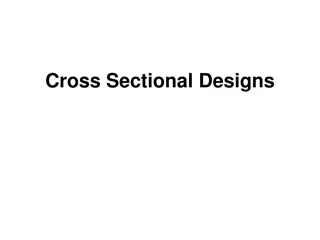
Understanding Research Designs and Approaches
Explore the major designs of research - qualitative and quantitative - to gain insight into their purposes, methodologies, and differences. This comparison delves into the qualitative vs. quantitative aspects of inquiry, hypotheses, and literature review techniques.
Download Presentation

Please find below an Image/Link to download the presentation.
The content on the website is provided AS IS for your information and personal use only. It may not be sold, licensed, or shared on other websites without obtaining consent from the author. If you encounter any issues during the download, it is possible that the publisher has removed the file from their server.
You are allowed to download the files provided on this website for personal or commercial use, subject to the condition that they are used lawfully. All files are the property of their respective owners.
The content on the website is provided AS IS for your information and personal use only. It may not be sold, licensed, or shared on other websites without obtaining consent from the author.
E N D
Presentation Transcript
Research Designs/Approaches & Types by Moazzam Ali Malik
Major Designs of Research Qualitative Research Quantitative Research
Qualitative Research is conducted to have a better understanding of not only about the current situation is but also why it is so is much broader in scope than the historical research is more open and responsive to the research participants uses a variety of methods and data collection strategies is characterized as multi-method offers opportunities for descriptive and exploratory studies Its overall purpose is to explain and gain insight and understanding of phenomena through intensive collection of narrative data. It is inductive and process-oriented
Quantitative Research Quantitative research involves the collection of numerical data It also involves the description of data, finding out the relationship among quantifiable variables and inferring of results. It depends on the statistical data analysis Its overall purpose is to explain, predict, or /and control phenomena through focused collection of numerical data. It is deductive, focused and outcome-oriented
Qualitative vs. Quantitative: A Step by Step Comparison Qualitative Quantitative Overall purpose Overall purpose Explain predict or /and control phenomena through focused collection of numerical data Explain and gain insight and understanding of phenomena through intensive collection of narrative data
Qualitative Quantitative Approach to Inquiry Approach to Inquiry Inductive Subjective Process oriented Deductive Objective Focused Outcome oriented
Qualitative Quantitative Hypotheses Hypotheses Tentative Specific Evolving Testable Based on particular study Stated prior to particular study
Qualitative Quantitative Review of related Literature Review of related Literature Extensive Limited Does significantly affect particular study Does not significantly affect particular study
Qualitative Quantitative Research setting Research setting Controlled to the degree possible Naturalistic to the degree possible
Qualitative Quantitative Sampling Sampling Random/Non-random Small Large Not necessarily representative Representative sample in order to generalize results to a population In order to acquire in depth understanding
Qualitative Quantitative Measurement Measurement Standardized Non standardized Numerical Narrative At the end Ongoing
Qualitative Quantitative Design and Method Design and Method Structured Inflexible Specified in detail in advance of study Involves intervention,manipulation and control Descriptive Co- relational Causal-comparative Experimental Flexible Specified only in general terms in advance of study Involves nonintervention Minimal disturbance Historical Ethnographic Case study
Qualitative Quantitative Data Collection Strategies Data Collection Strategies Non participant observation Semi-structured, formal interviews Administration of tests and questionnaires Document collection Participant observation Unstructured, informal interviews Taking extensive, detailed field notes
Qualitative Quantitative Data Analysis Data Analysis Raw data are words Raw data are numbers Essentially ongoing Performed at end of study Involves synthesis Involves statistics
Qualitative Quantitative Data interpretation Data interpretation Conclusions and generalizations formulated at the end of study Stated with predetermined degree of certainty Conclusions tentative Reviewed on ongoing basis Generalizations speculative
Present Trend in Research More Structured qualitative Research Increased application of both inquiry strategies in same study
Types of Qualitative & Quantitative Designs The Quantitative research designs; but one should be mindful of the fact that these designs of research cannot be strictly compartmentalized as; quite recently, many researchers in social sciences have advocated the mixed-method Moreover, Longitudinal research may involve both the Qualitative and Quantitative approaches. following slides list Qualitative and approach. Cross-sectional and
Types of Quantitative Research Experimental Research Non-experimental Research Quasi-experimental Research
Experimental & Non Experimental Studies Experimental research is when a researcher is able to manipulate the predictor variable and subjects to identify a cause-and-effect relationship. This typically requires the research to be conducted in a lab, with one group being placed in an experimental group, or the ones being manipulated, while the other is placed in a control group, or inert condition or non-manipulated group. A laboratory-based experiment gives a high level of control and reliability. Non-experimental research is the label given to a study when a researcher cannot control, manipulate or alter the predictor variable or subjects, but instead, relies on interpretation, observation or interactions to come to a conclusion. Typically, this means the non- experimental researcher must rely on correlations, surveys or case studies, and cannot demonstrate a true cause-and-effect relationship. Non-experimental research tends to have a high level of external validity, meaning it can be generalized to a larger population.
Experimental & Non Experimental Studies
Experimental Study Designs There are so many types of experimental design that not all of them can be considered here. This section, therefore, is confined to describing those most commonly used in the social sciences. These designs have been categorised as: the after-only experimental design; the before-and-after experimental design; the control group design; the double-control design; the comparative design; the matched control experimental design; the placebo design
Non-experimental Study Designs A design in which the researcher is a passive agent, who observes, measures, and describes a phenomenon as it occurs or exists. Descriptive Relationships Correlational Comparative Causal Comparative Surveys Cross-sectional Longitudinal
Quasi-experimental Research Participants are assigned to the groups based on some characteristics or quality which brought these people to the study Is also called post hoc research or after the fact research
Types Qualitative ResearchDesigns Following list comprises of most commonly used qualitative research designs. However, some of the given research designs can be used by applying quantitative techniques or a mixture of qualitative and quantitative techniques, both. Naturalistic and Ethnographic Research Historical Research Exploratory Research Action Research Case Studies Document Analysis/Interpretative Research Surveys Cross-sectional Longitudinal
Thanks Thanks






















